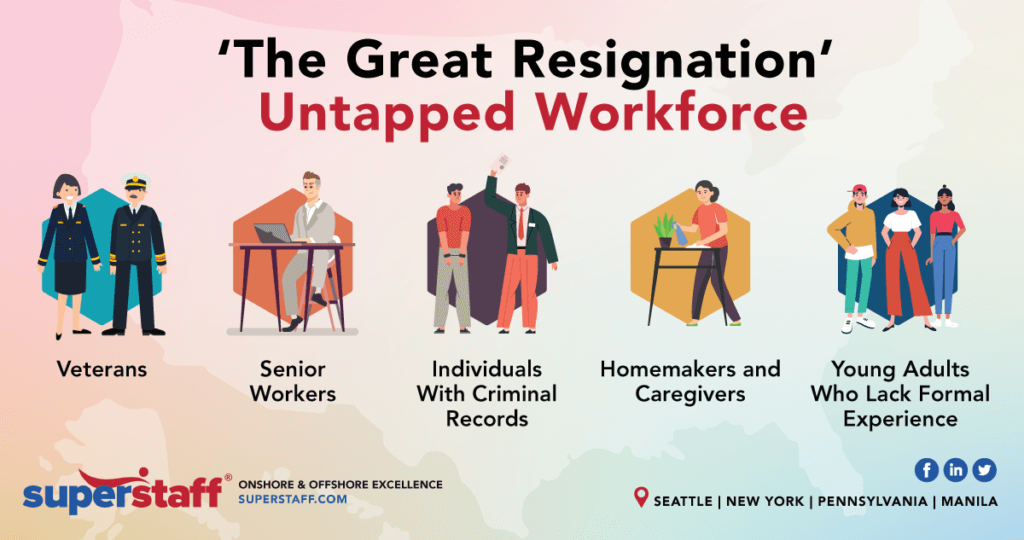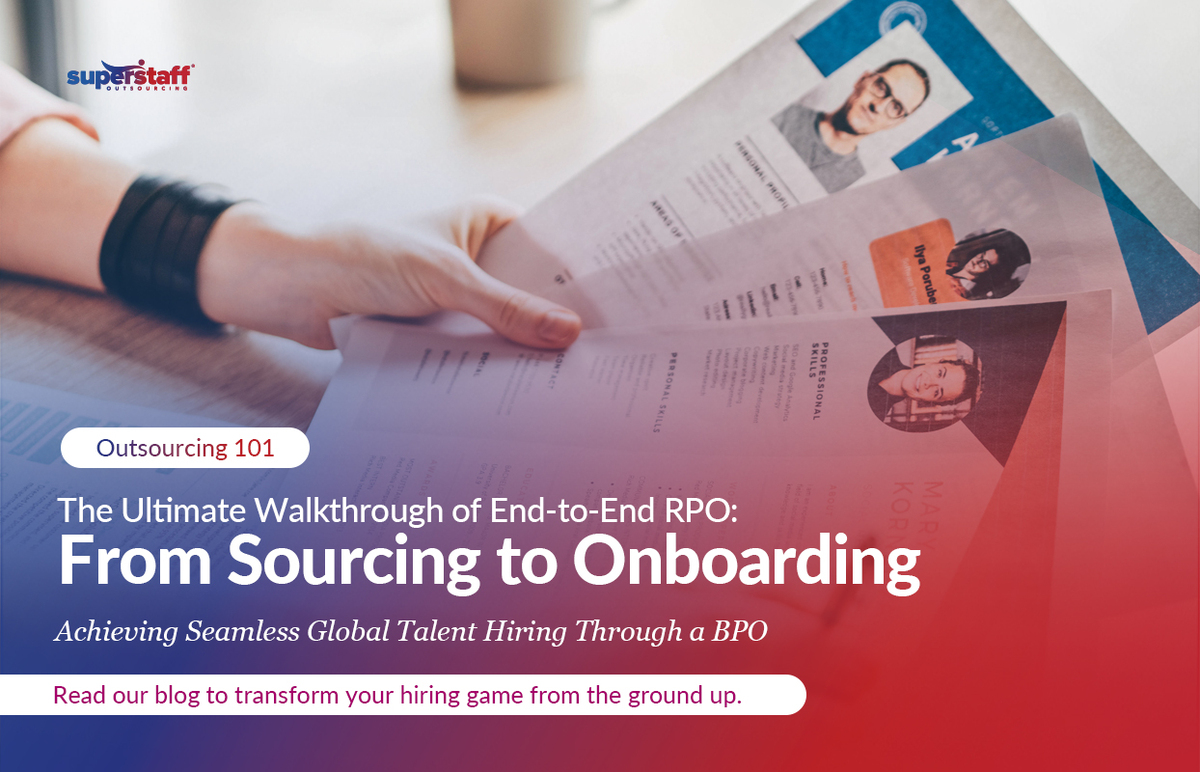
Where have all America’s talents gone? They might be hidden in plain sight, waiting for the right employers and opportunities to tap into their vast and unique potentials. The untapped workforce may be the key to surviving “The Great Resignation,” that’s creating a large gap between talents and job opportunities.
Take a Look at These ‘Great Resignation’ Statistics
September 2021:
- Job openings were at 10.4 million
- Hires were at 6.5 million
- Quit rates rose to an all-time high of 4.4 million
October 2021:
- Job openings increased to a near-record high of 11.0 million
- Hires were little changed at 6.5 million
- Quit rates decreased to 2.8 million
November 2021:
- Job openings were at 10.6 million
- Hires were at 6.7 million
- Quit rates increased to 4.4 million, matching September’s record-high rates
These numbers bring employers to a less optimistic trajectory. While there have been slight improvements in some areas, job openings, quit rates, and separations remain above pre-pandemic levels. Judging by these trends, the labor shortage will likely persist and the time has come once again to discover the untapped workforce of today.
During the pre-pandemic days and even before “The Great Resignation” set in, the untapped workforce comprised of the following:
- Veterans
- Senior Workers
- Individuals With Criminal Records
- Homemakers and Caregivers
- Young Adults Who Lack Formal Experience
However, the untapped workforce of 2022 may be different from who they used to be, and recruiters may need a little more digging to find them. Traditional recruitment strategies are not working. Employers need to explore creative solutions and start challenging their definitions of a good candidate.
Bridging the Talent Gap in the Time of ‘The Great Resignation’: Get to Know the Untapped Workforce of 2022
According to joint research of Harvard Business School and Accenture, hidden or untapped workforce members fall into three categories.
#1:‘Missing Hours’
Talents who are missing hours are full-time part-timers. They have at least one part-time job but are willing and able to take on full-time work. At about 63%, workers who are missing hours comprise the most significant portion of the untapped workforce in the U.S.
#2: ‘Missing From the Workforce’
Those who are missing from the workforce are neither employed nor seeking jobs. However, they are willing and able to work if presented with the right circumstances. Workers who fall under this category make up 33% of the total untapped workforce population in the U.S.
#3: ‘Missing From Work’
About 4% of the untapped workforce in the U.S. are missing from work. They are still seeking employment but have been unemployed for a long time. They also comprise the smallest share of the untapped workforce population in the U.S.

Where to Find Untapped Workforce
#1: Job Portals for Freelancers
Where did American workers go? About 34% of them are freelancing. In 2019, there were about 60 million freelancers in the U.S. Due to COVID, another 2 million entered the gig economy for the first time and contributed to the industry’s exponential growth. In 2020, the freelance economy grew 8.25 times faster than the entire U.S. economy.
So, if you want to expand your talent mining field, take advantage of the abundance of workers who found permanent virtual offices on various freelance job portals. With the rise of remote work and recruitment technology, reaching out to talents from anywhere in the world is way more accessible than ever.
#2: Sites Frequented by Millennial Moms
Digital natives and experts in navigating multiple screens and online destinations at once, millennial moms make an excellent addition to America’s fast-becoming-tech-centric work landscape.
On average, millennial moms maintain 3.4 social network accounts, and nearly 91% of them use these platforms regularly. They also frequent blogs and online parenting communities, spending 60% more time on these sites than other demographics.
To spark the interest of this population, employers need to understand their inner motivations. What matters to millennial moms? What are their priorities? From there, recruiters can tailor communication styles and develop targeted job advertisements that highlight how their company’s values align with millennial moms.
#3: Gen Zs’ Favorite Online Hangouts
Gen Zs make up about 40% of the U.S. population. In 2020, an estimated 61 million Gen Zs entered the workforce and were expected to disrupt the labor market.
More pragmatic than their millennial counterparts, Gen Zs are motivated by salary and benefits that enhance long-term security. They are also a highly competitive, career-oriented, and independent generation of workers. According to a study by Concordia University, St. Paul:
- 65% of Gen Zs thinks that salary is important
- 70% are primarily motivated by salary
- 70% say health insurance is the top non-negotiable benefit they are after
- 58% are willing to work nights and weekends for higher pay
Surrounded by technology all their lives, Gen Zs are the most highly digital among the rest of the working population. This trait, along with their career-driven nature, makes this generation an asset to employers.
So, where can you find Gen Z talents? Most of them spend at least 10 hours a day toggling between these platforms:
- TikTok – 60% of the overall TikTok users are Gen Zs
- Netflix – 71% of Gen Zs have a Netflix subscription
- YouTube – 79% of Gen Zs watch online and offline YouTube videos
- Instagram – Gen Zs recorded a 67% usage rate of the platform in 2021
- Snapchat – The Snapchat usage rate of Gen Zs in 2021 was 60%
How To Recruit Untapped Workforce
#1: Know What the Workforce Value and Want the Most
Job seekers have the most significant advantage in a labor market with more vacancies than workers. The high demand for talent across industries paved a recruiting environment where job seekers are in control. Knowing what employees want should be a priority of every employer.
Here are some ways you can keep up with the current workforce trends and attract candidates:
-
Redesign Your Work Structure
With the rise of remote work, flatter organizational structures are gaining traction. This framework has fewer hierarchical levels compared to traditional workplace structures. The removal of excess management layers creates an environment that promotes employee autonomy and relational authenticity, two significant motivating factors for many job seekers today.
-
Offer Hybrid Work
Among the drivers of “The Great Resignation” are employees who don’t want to go back to the offices. Gallup revealed that about 51% of employees wanted to continue to work remotely. However, a full-time remote setup may not be ideal for all industries and organizations. If your business is among these, find the middle ground by offering hybrid work arrangements.
-
Provide More Flexibility
According to Forbes, many Americans joined the freelance economy because they wanted a greater sense of freedom. Aside from offering hybrid or remote work arrangements, develop other ways to create a more flexible work environment.
For instance, if you employ a hybrid setup, you may allow your employees to choose when and how many days of the week they can work at home. You may also give them more flexibility in terms of their working hours.
Read more: Job Seekers’ Wishlist 2022: Top 7 Hiring Practices to Implement Amid ‘The Great Resignation.’
#2: Outsource Your Recruitment
Did you know that about 28% of millennial managers doubt their competencies to effectively engage, train, and retain the highly sought-after Gen Zs? If you are among these managers or if your line of business has little to do with recruitment, your best bet to resolving your organization’s talent gap is to turn to the experts.
Recruitment process outsourcing providers are equipped with the knowledge of workforce trends and strategies relevant to the changing dynamics of the labor market. They know where talents are, including the untapped workforce, and how to bring your company closer to them.
Read more: The Future of Recruitment Process Outsourcing: 2021 Hiring Trends That Address the Hybrid Work Model
#3: Outsource Your Talents
A larger population of the untapped workforce is based outside the U.S. The Philippines, for instance, has a surplus of about 13.5 million adult workers. Outsourcing to the country enables you to tap into to wider pool of talents willing and able to elevate your organization’s workforce value.
Apart from access to a larger workforce, the Philippines offer many economic and strategical advantages to U.S. businesses. These benefits include favorable tax policies and regulatory climate.
Read more: 5 Reasons to Choose Customer Service Outsourcing in the Philippines
Stay on Top of the Latest Workforce Trends in 2022 and Beyond
At SuperStaff, we keep ourselves abreast of the crucial trends affecting the U.S. and global labor landscape. We develop outsourcing solutions that are relevant, timely, and practical. Schedule a consultation with us. Allow us to help you overcome “The Great Resignation” and other business challenges that may come your way.






